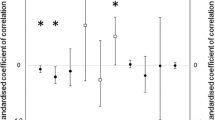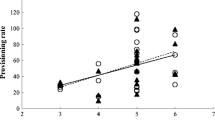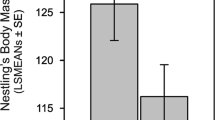Abstract
Foraging behavior may show considerable variation among population classes—such as sex and breeding class—that can be consequence of the groups’ specific constraints and roles. In raptors, differential parental roles related to foraging have been the main explanation for males being smaller than females, as smaller males have been described to be more efficient foragers. During one phase of breeding, only males forage, requiring them to feed themselves, females and young. This is expected to induce changes in foraging behavior of breeders compared to non-breeders. By comparing prey taken by floaters and breeders of Harpy Eagles (Harpia harpyja), we describe some effects of breeding and sex on the diet. Here we show that diet traits differed between male and female floaters, and between floaters and breeders. Juvenile prey was three times more common in the diet of males than that of females. Sloths were more common prey among females than among males (53 vs. 37%). Males preyed four times more on terrestrial animals than did females, and showed a greater niche width than females (6.0 vs. 3.4). The prey of breeders was smaller than that of non-breeders (on average 3.64 vs. 4.24 kg). Non-breeders had a larger niche width than breeders. Our data provide support for the hypothesis of parental role differentiation as an explanation for reversed sexual size dimorphism in raptors.
Zusammenfassung
Geschlecht und Brutstatus beeinflussen die Beutezusammensetzung von Harpyien
Das Verhalten bei der Nahrungssuche kann sich zwischen den Populationsklassen—wie beispielweise Geschlecht und Brutklasse—beträchtlich unterscheiden, welches eine Folge der spezifischen Beschränkungen und Rollen dieser Gruppen sein kann. Bei Greifvögeln gelten die unterschiedlichen Rollen der Elternvögel bei der Nahrungssuche als die hauptsächliche Erklärung dafür, dass die Männchen kleiner sind als die Weibchen, da die kleineren Männchen als die effizienteren Jäger gelten. Während eines Abschnitts des Brutgeschehens jagen nur die Männchen, welche daher nicht nur sich selbst, sondern auch noch die Weibchen und die Jungvögel mit Nahrung versorgen müssen. Dies lässt Änderungen im Jagdverhalten zwischen Brutvögeln und Nichtbrütern erwarten. Im Vergleich von Beutetieren nicht-territorialer Harpyien (Harpia harpyja) mit denen von Brutvögeln beschreiben wir einige Einflüsse von Brutstatus und Geschlecht auf die Nahrungszusammensetzung. Hier zeigen wir, dass sich die Ernährungsgewohnheiten nicht-territorialer Männchen und Weibchen sowie diejenigen der nicht-territorialen Vögel und Brutvögel unterscheiden. Im Nahrungsspektrum der Männchen waren Jungtiere dreimal häufiger vertreten als in dem der Weibchen. Faultiere wurden häufiger zur Beute von Weibchen als von Männchen (53% gegenüber 37%). Männchen erbeuteten viermal häufiger bodenlebende Tiere als die Weibchen und wiesen eine größere Nischenbreite auf als diese (6,0 gegenüber 3,4). Die Beutetiere der Brutvögel waren kleiner als die der Nichtbrüter (im Schnitt 3,64 kg gegenüber 4,24 kg). Nichtbrüter nutzten eine größere Nischenbreite als Brutvögel. Unsere Daten unterstützen die Hypothese der elterlichen Rollenverteilung als Erklärung für den umgekehrten Größendimorphismus bei Greifvögeln.


Similar content being viewed by others
References
Aguiar-Silva F, Sanaiotti T, Luz B (2014) Food habits of the Harpy Eagle, a top predator from the Amazonian rainforest canopy. J Raptor Res 48:24–45
Aguiar-Silva FH, Junqueira TG, Sanaiotti TM et al (2015) Resource availability and diet in Harpy Eagle breeding territories on the Xingu River, Brazilian Amazon. Braz J Biol 75:181–189. doi:10.1590/1519-6984.00914BM
Alvarez-Cordero E (1996) Biology and conservation of the Harpy Eagle in Venezuela and Panama. DSc Thesis. University of Florida, Florida, USA
ANAM (2016) Parque Nacional Soberania. In: Aut. Nac. del Ambient. http://web.archive.org/web/20131105133636/http://www.anam.gob.pa/soberania/. Accessed 2 Jun 2016
Andersson MB (1994) Sexual selection. Princeton University Press, Princeton
Andersson M, Norberg R (1981) Evolution of reversed sexual size dimorphism and role partitioning among predatory birds, with a size scaling of flight performance. Biol J Linn Soc 15:105–130
Angel LP, Wells MR, Rodríguez-Malagón MA, Tew E, Speakman JR, Arnould JP (2015) Sexual size dimorphism and body condition in the Australasian gannet. PLoS One 10:e0142653
Banhos A, Hrbek T, Sanaiotti TM, Farias IP (2016) Reduction of genetic diversity of the Harpy Eagle in brazilian tropical forests. PLoS One 11:e0148902. doi:10.1371/journal.pone.0148902
Barrows C (1987) Diet shifts in breeding and nonbreeding spotted owls. J Raptor Res 21:95–97
Birdlife International (2016) Harpia harpyja (American Harpy Eagle, Harpy Eagle). In: IUCN red list threat. species. Version 2014.2. http://www.iucnredlist.org/details/22695998/0. Accessed 1 Jan 2016
Bonal R, Aparicio JM (2008) Evidence of prey depletion around lesser kestrel Falco naumanni colonies and its short term negative consequences. J Avian Biol 39:189–197. doi:10.1111/j.2008.0908-8857.04125.x
Campbell-Thompson E, Vargas FH, Watson RT et al (2012) Effect of sex and age at release on the independence of hacked Harpy Eagles. J Raptor Res 46:158–167. doi:10.3356/JRR-10-74.1
Caro J, Ontiveros D, Pizarro M, Pleguezuelos JM (2010) Habitat features of settlement areas used by floaters of Bonelli’s and Golden Eagles. Bird Conserv Int 21:59–71. doi:10.1017/S0959270910000213
Caro J, Ontiveros D, Pleguezuelos JM (2011) The feeding ecology of Bonelli’s eagle (Aquila fasciata) floaters in southern Spain: implications for conservation. Eur J Wildl Res 57:729–736. doi:10.1007/s10344-010-0480-z
Catry I, Catry T, Alho M et al (2016) Sexual and parent-offspring dietary segregation in a colonial raptor as revealed by stable isotopes. J Zool 299:58–67. doi:10.1111/jzo.12324
Collopy MW (1984) Parental care and feeding ecology of Golden Eagle nestlings. Auk 101:753–760
Darwin C (1859) The origin of species by means of natural selection: or, the preservation of favored races in the struggle for life, 5th edn. John Murray, London
de Vargas-González J, Vargas FH (2011) Nesting density of Harpy Eagles in Darien with population size estimates for Panama. J Raptor Res 43:199–210
Fisher R (1930) The genetical theory of natural selection: a complete, variorum edn. Oxford University Press, Oxford
Fowler J, Cope J (1964) Notes on the Harpy Eagle in British Guiana. Auk 81:257–273
Galetti M, de Carvalho O Jr (2000) Sloths in the diet of a Harpy Eagle nestling in Eastern Amazon. Wilson Bull 112:535–536
Goffart M (1971) Function and form in the sloth. Pergamon Press, New York
Gotelli N, Entsminger G (2006) EcoSim: null models software for ecology
Hakkarainen H, Korpimäki E (1991) Reversed sexual size dimorphism in Tengmalm’s owl: is small male size adaptive? Oikos 61:337–346
Hakkarainen H, Huhta E, Lahti K et al (1996) A test of male mating and hunting success in the kestrel: the advantages of smallness? Behav Ecol Sociobiol 39:375–380. doi:10.1007/s002650050303
Hayward MW, Hayward GJ, Tambling CJ, Kerley GIH (2011) Do lions Panthera leo actively select prey or do prey preferences simply reflect chance responses via evolutionary adaptations to optimal foraging? PLoS One 6:e23607. doi:10.1371/journal.pone.0023607
Heckadon S, Ibañez R, Condit R (1999) La cuenca del canal: deforestación, urbanización y contaminación: proyecto de monitoreo de la cuenca del canal de panama (PMCC), sumario ejecutivo del informe final. Smithsonian Tropical Research Institute
Izor R (1985) Sloths and other mammalian prey of the Harpy Eagle. In: Montgomery G (ed) The evolution and ecology of armadillos, sloths, and vermilinguas. Smithsonian Institution, Washington
Katzner T, Miller TA, Rodrigue J, Shaffer S (2015) A most dangerous game: death and injury to birds from porcupine quills. Wilson J Ornithol 127:102–108
Kitowski I (2008) Social learning of hunting skills in juvenile marsh harriers Circus aeruginosus. J Ethol 27:327–332. doi:10.1007/s10164-008-0123-y
Krebs C (1999) Ecological methodology. Benjamin/Cummings, Menlo Park
Krüger O (2005) The evolution of reversed sexual size dimorphism in hawks, falcons and owls: a comparative study. Evol Ecol 19:467–486. doi:10.1007/s10682-005-0293-9
Mayer M, Shine R, Brown G (2016) Bigger babies are bolder: effects of body size on personality of hatchling snakes. Behaviour 153:313–323
Miranda E (2015) Conservation implications of Harpy Eagle Harpia harpyja predation patterns. Endanger Species Res 29:69–79
Muela A, Watson R, Mutch B, Heinrich W (2003) The Harpy Eagle: biology, restoration and hacking procedures. Ciudad de Panamá
Muñiz-López R (2008) Revisión de la situación del Águila Harpía Harpia harpyja en Ecuador. Cotinga 29:42–47
Muñiz-López R, Criollo O, Mendúa A (2007) Results of five years of the “Harpy Eagle (Harpia harpyja) Research Program” in the Ecuadorian tropical forest. In: Bildstein K, Barber D, Zimmerman A (eds) Neotropical raptors. Hawk Mountain Sanctuary, Orwigsburg, USA, pp 22–32
Muñiz-López R, Limiñana R, Cortés G, Urios V (2012) Movements of Harpy Eagles Harpia harpyja during their first two years after hatching. Bird Study 59:509–514
Nilsson IN, Nilsson SG, Sylvén M (1982) Diet choice, resource depression, and the regular nest spacing of birds of prey. Biol J Linn Soc 18:1–9. doi:10.1111/j.1095-8312.1982.tb02030.x
Oksanen J, Kindt R, Legendre P et al (2007) The vegan package
Olsen J, Judge D, Trost S, Rose A (2013) Does the relative abundance of large versus small arboreal marsupials determine sexual dimorphism in powerful Owls? Aust F Ornithol 30:22–39
Piana R (2007) Anidamiento y dieta de Harpia harpyja Linnaeus en la Comunidad Nativa de Infierno, Madre de Dios, Perú. Rev Peru Biol 14:135–138
Rettig N (1978) Breeding behavior of the Harpy Eagle (Harpia harpyja). Auk 95:629–643
Reynolds R (1972) Sexual dimorphism in accipiter hawks: a new hypothesis. Condor 72:191–197
Rotenberg J, Marlin J, Pop L, Garcia W (2012) First record of a Harpy Eagle (Harpia harpyja) nest in Belize. Wilson J o 124:292–297
Rutz C, Bijlsma RG (2006) Food-limitation in a generalist predator. Proc R Soc B Biol Sci 273:2069–2076. doi:10.1098/rspb.2006.3507
Sanaiotti T, Rittl C, Luz BB, Soler S (2001) Dieta de filhotes de Harpia harpyja na região de Manaus. In: Straube FC (ed) Ornitologia sem fronteiras. Pontifícia Universidade Católica do Paraná, Curitiba, pp 349–350
Schmutz JK, Gérard MA, Court GS, Nelson RW (2014) Parental care by lone male Ferruginous Hawks (Buteo regalis), Rough-legged Hawks (Buteo lagopus), and Great Horned Owls (Bubo virginianus) was limited to providing food. Can Field-Naturalist 128:145–150
Seymour A, Hatherley G, Contreras FJ et al (2010) Hatching synchrony, green branch collecting, and prey use by nesting Harpy Eagles (Harpia harpyja). Wilson J Ornithol 122:792–795
Slagsvold T, Sonerud GA (2007) Prey size and ingestion rate in raptors: importance for sex roles and reversed sexual size dimorphism. J Avian Biol 38:650–661
Slagsvold T, Sonerud GA, Grønlien HE, Stige LC (2010) Prey handling in raptors in relation to their morphology and feeding niches. J Avian Biol 41:488–497
Sonerud GA, Steen R, Løw LM, Røed LT, Skar K, Selås V, Slagsvold T (2013) Size-biased allocation of prey from male to offspring via female: family conflicts, prey selection, and evolution of sexual size dimorphism in raptors. Oecologia 172:93–107
Sonerud GA, Steen R, Løw LM, Røed LT, Skar K, Selås V, Slagsvold T (2014) Evolution of parental roles in raptors: prey type determines role asymmetry in the Eurasian kestrel. Anim Behav 96:31–38
Springer MT, Nielsen CK, Carver AD, Correa NJ (2011) Harpy Eagle (Harpia harpyja) feeding behavior on a brown-throated three-toed sloth (Bradypus variegates). J Raptor Res 45:100–103. doi:10.3356/JRR-10-45.1
Taube E, Vie J-C, Fournier P et al (1999) Distribution of two sympatric species of sloths (Choloepus didactylus and Bradypus tridactylus) along the Sinnamary River, French Guiana1. Biotropica 31:686–691. doi:10.1111/j.1744-7429.1999.tb00418.x
Touchton J (2010) The Harpy Eagle. In: Tingay R, Katzner T (eds) The eagle watchers: observing and conserving raptors around the world, 1st edn. Cornell University Press, Cornell, p 264
Touchton J, Hsu Y, Palleroni A (2002) Foraging ecology of reintroduced captive-bred subadult Harpy Eagles (Harpia harpyja) on Barro Colorado Island, Panama. Ornitol Neotrop 13:365–379
Watson J (2010) The golden eagle. Bloomsbury Publishing, Poyser
Watson RT, McClure CJW, Vargas FH, Jenny JP (2016) Trial restoration of the Harpy Eagle, a large, long-lived, tropical forest Raptor, in Panama and Belize. J Raptor Res 50:3–22. doi:10.3356/rapt-50-01-3-22.1
Wishnie MH, Dent DH, Mariscal E et al (2007) Initial performance and reforestation potential of 24 tropical tree species planted across a precipitation gradient in the Republic of Panama. For Ecol Manag 243:39–49. doi:10.1016/j.foreco.2007.02.001
Zahavi A (1975) Mate selection—a selection for a handicap. J Theor Biol 53:205–214. doi:10.1016/0022-5193(75)90111-3
Zhang J, Ding Q, Huang J (2013) SPAA: species association analysis
Acknowledgements
We thank the many donors who supported The Peregrine Fund’s Harpy Eagle Restoration Program: The U.S. Agency for International Development (USAID), Archie W. and Grace Berry Foundation, Burns Family Foundation, Butler Foundation, CEMEX Panama, Jim and Barbara Cimino, Liz Claiborne and Art Ortenberg Foundation, Disney Worldwide Conservation Fund, Walt Disney Company Foundation, Evie Donaldson, Charles Engelhard Foundation, ExxonMobil Foundation, Greater Los Angeles Zoo Association, Howard Gilman Foundation, Houston Zoo, Diane A. Ledder Charitable Trust, Ledder Family Charitable Trust, Mr. and Mrs. Peter Manigault, Ruth O. Mutch, Newman’s Own Organics, Norcross Wildlife Foundation, Offield Family Foundation, Paxson H. Offield, Pennzoil-Quaker State Company, Don Tyson, Wallace Genetic Foundation, Julie A. Wrigley, Wolf Creek Charitable Foundation, Zoological Society of San Diego, and other important donors. EBPM thanks Rufford Small Grants (Grant no. 18743-1), Rainforest Biodiversity Group, Idea Wild and The Explorers Club Exploration Fund–“Mamont Scholars Program” for their financial support. EBPM received logistical support from the Peugeot-ONF Carbon Sink Reforestation Project, based at the São Nicolau Farm in Cotriguaçu, Mato Grosso, Brazil. This Project is a Peugeot initiative to fulfill some of the Kyoto Protocol directions and is run by the ONF-Brasil enterprise. Victor Landeiro and Marcelo “Salsicha” Segall provided useful discussions on data analysis and theory. All research protocols and capture procedures applied for Harpy Eagles in Soberania National Park were approved by the National Environmental Authority of Panama Committee on Animal Care and were in accordance with the Guidelines of The Peregrine Fund’s Council on Animal Care. The Peregrine Fund´s Harpy Eagle Restoration Program complied with the laws of Panama during the time in which the project was carried out. We also thank staff and volunteers who have participated in The Peregrine Fund’s Harpy Eagle Restoration Program.
Author information
Authors and Affiliations
Corresponding author
Additional information
Communicated by O. Krüger.
Electronic supplementary material
Below is the link to the electronic supplementary material.
Rights and permissions
About this article
Cite this article
Miranda, E.B.P., Campbell-Thompson, E., Muela, A. et al. Sex and breeding status affect prey composition of Harpy Eagles Harpia harpyja . J Ornithol 159, 141–150 (2018). https://doi.org/10.1007/s10336-017-1482-3
Received:
Revised:
Accepted:
Published:
Issue Date:
DOI: https://doi.org/10.1007/s10336-017-1482-3




